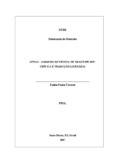| dc.creator | Tavares, Enéias Farias | |
| dc.date.accessioned | 2008-04-07 | |
| dc.date.available | 2008-04-07 | |
| dc.date.issued | 2007-02-19 | |
| dc.identifier.citation | TAVARES, Enéias Farias. Othello - the moor of Venice, by Shakespeare: literary criticism and translation. 2007. 284 f. Dissertação (Mestrado em Letras) - Universidade Federal de Santa Maria, Santa Maria, 2007. | por |
| dc.identifier.uri | http://repositorio.ufsm.br/handle/1/9773 | |
| dc.description.abstract | The play Othello - The moor of Venice by Shakespeare has had several translations in Brazil.
Some of the translators are Onestaldo of Pennafort, Carlos Alberto Nunes, Barbara Heliodora
and Beatriz Viegas-Faria. While Pennafort, Nunes and Heliodora translated the play using a
ten-syllable verse, Viégas-Faria translated the tragedy in prose. The aim of this study is to
analyze the reviews and the translations of the play in order to think about new possibilities of
poetic translation of this Shakespearean play. This master's thesis, entitled "Othello The
moor of Venice: Literary Criticism and Translation", is divided in five chapters. In the first
chapter, "Sources and influences of the play", the main themes used by Shakespeare to
compose his tragedy such as the medieval moralities; the Italian tale by Cinthio; the Italian
characters of the Commedia Dell'Arte and the Elizabethan/Jacobean idea about the moors are
analyzed. In the second, "Othello criticism: a study of the characters in the tragedy", a
discussion based on the opinion of the main reviewers of the play is proposed. In the third
chapter, "The psychological change in the discourse of the protagonist of Othello", the focus
is on the changes that the protagonist's language goes through as his suspicion develops. In
the fourth chapter, entitled "Between the Shakespearean prose and verse: Brazilian
translations of Othello", the history of the play in Brazil is presented through the discussion of
the four translations of it made into Portuguese. In the last chapter, "A new poetic translation
of Othello - The moor of Venice: among the tragic, the comic and the lyric", the poetical and
sonorous choices of metrics used in this new translation are described. Also the results of this
translation, in which the thematic and stylistic variations of the tragedy become clear, are
presented. Finally, there are four appendices to complement this work. In appendix A, there
is important information on Shakespeare's play; in appendix B, my translation of the Cinthio's
tale, used by Shakespeare to compose his drama, is presented; in Appendix C, there are
images of the period in which Othello was written and pictures of some actors that played
different roles in the tragedy. Finally, in appendix D, the first translation made by me of
Othello The moor of Venice is presented. | eng |
| dc.description.sponsorship | Coordenação de Aperfeiçoamento de Pessoal de Nível Superior | |
| dc.format | application/pdf | por |
| dc.language | por | por |
| dc.publisher | Universidade Federal de Santa Maria | por |
| dc.rights | Acesso Aberto | por |
| dc.subject | Literatura | por |
| dc.subject | Literatura inglesa | por |
| dc.subject | Crítica literária | por |
| dc.subject | Teatro | por |
| dc.subject | Tragédia | por |
| dc.title | Otelo - o mouro de Veneza, de Shakespeare: crítica e tradução literária | por |
| dc.title.alternative | Othello - the moor of Venice, by Shakespeare: literary criticism and translation | eng |
| dc.type | Dissertação | por |
| dc.description.resumo | No Brasil, Otelo o mouro de Veneza já foi traduzido diversas vezes. Entre os tradutores, encontram-se Onestaldo de Pennafort, Carlos Alberto Nunes, Barbara Heliodora e Beatriz
Viégas-Faria. Enquanto os três primeiros traduziram a peça em verso decassílabo, correspondente métrico do pentâmetro iâmbico shakespeariano, a última traduziu a tragédia
em prosa. O objetivo deste trabalho, que visa à obtenção do título de mestre, é estudar a crítica e as traduções da peça como auxílio a uma nova tradução versificada do texto de
Shakespeare. Esta dissertação de mestrado, intitulada Otelo O mouro de Veneza, de Shakespeare: Crítica e Tradução Literária , está dividida em cinco capítulos. No primeiro, Fontes e influências da peça , tratei dos principais temas usados por Shakespeare ao compor sua tragédia: as moralidades medievais; o conto italiano de Cinthio; as personagens tipificadas da commedia dell arte italiana e a visão elisabetana/jacobina sobre os mouros. No segundo, A crítica de Otelo: um estudo das personagens da tragédia , busquei uma discussão fundamentada nas principais opiniões críticas sobre o drama. No terceiro capítulo, A
variação psicológica no discurso da protagonista de Otelo , comentei a transformação que as falas da personagem sofrem no decorrer do aprofundamento de sua suspeita. No quarto
capítulo, intitulado Entre a prosa e o verso de Shakespeare: traduções brasileiras de Otelo , aludi ao histórico da peça no Brasil fazendo referência a quatro das traduções feitas para o
português brasileiro. No último capítulo, Uma nova tradução poética de Otelo O mouro de Veneza: entre o trágico, o cômico e o lírico , descrevo as escolhas métricas e sonoras
buscadas nessa nova tradução e apresento alguns resultados deste trabalho de tradução, em que as variações temáticas e estilísticas da tragédia se fizeram presentes, recriadas, nesta nova tradução. Finaliza o trabalho, no Apêndice D, a primeira versão desta nova tradução de Otelo O mouro de Veneza, de Shakespeare. | por |
| dc.contributor.advisor1 | Pereira, Lawrence Flores | |
| dc.contributor.advisor1Lattes | http://lattes.cnpq.br/2329033954605102 | por |
| dc.contributor.referee1 | Maggio, Sandra Sirangelo | |
| dc.contributor.referee1Lattes | http://lattes.cnpq.br/0866814477504163 | por |
| dc.contributor.referee2 | Silva, Vera Lucia Lenz Vianna da | |
| dc.contributor.referee2Lattes | http://lattes.cnpq.br/8773425081130876 | por |
| dc.creator.Lattes | http://lattes.cnpq.br/1655076745935830 | por |
| dc.publisher.country | BR | por |
| dc.publisher.department | Letras | por |
| dc.publisher.initials | UFSM | por |
| dc.publisher.program | Programa de Pós-Graduação em Letras | por |
| dc.subject.cnpq | CNPQ::LINGUISTICA, LETRAS E ARTES::LETRAS | por |


